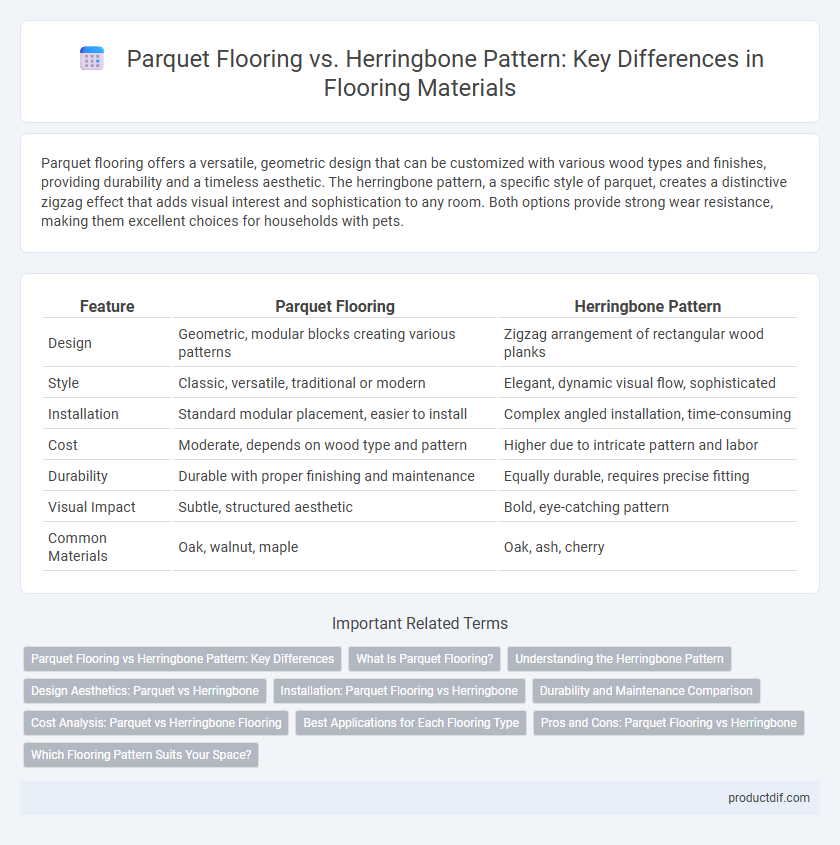Parquet flooring offers a versatile, geometric design that can be customized with various wood types and finishes, providing durability and a timeless aesthetic. The herringbone pattern, a specific style of parquet, creates a distinctive zigzag effect that adds visual interest and sophistication to any room. Both options provide strong wear resistance, making them excellent choices for households with pets.
Table of Comparison
| Feature | Parquet Flooring | Herringbone Pattern |
|---|---|---|
| Design | Geometric, modular blocks creating various patterns | Zigzag arrangement of rectangular wood planks |
| Style | Classic, versatile, traditional or modern | Elegant, dynamic visual flow, sophisticated |
| Installation | Standard modular placement, easier to install | Complex angled installation, time-consuming |
| Cost | Moderate, depends on wood type and pattern | Higher due to intricate pattern and labor |
| Durability | Durable with proper finishing and maintenance | Equally durable, requires precise fitting |
| Visual Impact | Subtle, structured aesthetic | Bold, eye-catching pattern |
| Common Materials | Oak, walnut, maple | Oak, ash, cherry |
Parquet Flooring vs Herringbone Pattern: Key Differences
Parquet flooring consists of geometric wood pieces arranged in various patterns, offering versatile design options and a modern aesthetic. The herringbone pattern is a specific type of parquet featuring rectangular planks laid in a zigzag formation, creating a distinctive V-shaped visual effect. While parquet flooring encompasses multiple styles, herringbone stands out for its classic, timeless appeal and increased installation complexity.
What Is Parquet Flooring?
Parquet flooring consists of small wooden pieces arranged in geometric patterns, creating a visually striking and durable surface often found in classic and modern interiors. The herringbone pattern is a specific type of parquet design that features rectangular planks laid in a zigzag pattern, enhancing the floor's texture and depth. Parquet flooring offers versatility in design and wood species, making it a popular choice for both aesthetics and longevity in residential and commercial spaces.
Understanding the Herringbone Pattern
The Herringbone pattern in flooring consists of rectangular parquet pieces arranged in a zigzag design, creating a distinctive V-shaped weave that adds texture and visual interest to any space. This pattern differs from traditional parquet flooring, which may follow simpler geometric layouts like squares or rectangles, offering a more complex and dynamic aesthetic. Understanding the Herringbone pattern helps homeowners appreciate its craftsmanship and the way it enhances room dimensions through its angular alignment.
Design Aesthetics: Parquet vs Herringbone
Parquet flooring offers a versatile design with geometric patterns that create a timeless, elegant look suitable for both classic and modern interiors. Herringbone pattern flooring stands out with its distinctive zigzag arrangement, adding dynamic movement and visual interest to any space. Both options enhance room aesthetics, but herringbone often serves as a statement piece, while parquet provides broader design adaptability.
Installation: Parquet Flooring vs Herringbone
Parquet flooring installation involves arranging small wood pieces in geometric patterns, allowing for quicker and more straightforward fitting compared to herringbone, which requires precise alignment of rectangular planks at a 45-degree angle. Herringbone installation is more labor-intensive and time-consuming due to the meticulous pattern matching and complex subfloor preparation needed to achieve its distinct zigzag design. Both require professional expertise, but herringbone demands higher skill and precision, often resulting in increased installation costs.
Durability and Maintenance Comparison
Parquet flooring, composed of small wood pieces arranged in geometric patterns, typically offers strong durability due to its solid hardwood construction and can withstand heavy foot traffic. The herringbone pattern, a specific type of parquet, may require more precise installation and regular maintenance to preserve its intricate design, although both styles generally benefit from similar cleaning routines such as sweeping and occasional refinishing. Durability for both depends largely on the wood species used, with harder woods like oak providing enhanced resistance to wear and easier maintenance compared to softer alternatives.
Cost Analysis: Parquet vs Herringbone Flooring
Parquet flooring generally offers a more cost-effective solution compared to herringbone patterns due to simpler installation processes and reduced labor costs. Herringbone flooring requires precise craftsmanship and additional time, increasing overall expenses by 15-30% depending on wood type and room size. Material costs for both options vary based on wood species, but installation complexity primarily drives the price differentiation in parquet vs. herringbone flooring.
Best Applications for Each Flooring Type
Parquet flooring is ideal for traditional and formal spaces, offering geometric variety and a polished, sophisticated look that enhances large rooms and hallways. Herringbone pattern flooring is best suited for modern and eclectic interiors, providing dynamic visual movement that complements smaller spaces and adds depth to open-plan areas. Both flooring types use hardwood but serve different aesthetic and spatial functions based on room size and design style preferences.
Pros and Cons: Parquet Flooring vs Herringbone
Parquet flooring offers versatile geometric designs with easy installation and good durability, making it suitable for various interior styles, but it can be prone to scratches and requires regular maintenance. Herringbone pattern, a type of parquet, provides a distinctive, elegant look with enhanced visual texture and added room depth, though it tends to be more expensive and complex to install than standard parquet. Both options use hardwood materials like oak or walnut, but herringbone's intricate layout demands higher craftsmanship and can increase project costs and installation time.
Which Flooring Pattern Suits Your Space?
Parquet flooring offers a versatile, geometric design that complements both traditional and modern interiors, providing durability and easy maintenance suitable for high-traffic areas. The herringbone pattern, characterized by its distinctive V-shaped, zigzag layout, adds a sophisticated, dynamic visual appeal ideal for creating focal points in living rooms or hallways. Choosing between parquet and herringbone depends on your space size, style preference, and whether you want a uniform look or a bold architectural statement.
Parquet flooring vs Herringbone pattern Infographic

 productdif.com
productdif.com